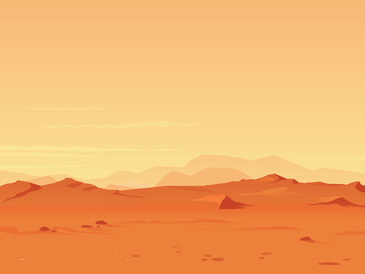The Center for Computing and Communication Technologies (TZI) of the University of Bremen is developing a detailed simulation of Valles Marineris on Mars for the DLR Explorer project. In the virtual environment, the collaboration of autonomous space robots is to be rehearsed under real conditions.
A flight from Earth to Mars takes about six to eight months if the distance between the two orbits is short. Due to the long and expensive journey, it is crucial for space missions that all technical equipment function smoothly on-site. Under the direction of Professor Gabriel Zachmann, scientists from the Center for Computing and Communication Technologies (TZI) at the University of Bremen are therefore currently developing a detailed simulation of 40 square kilometers of the surface of Mars. In addition, they are allowing several research groups to test the collaboration of space robots in swarms in this virtual world.
Largest Canyon Landscape in the Solar System
The simulation is being developed as part of the VaMEx-VTB project. The abbreviation stands for “Valles Marineris Explorer – Virtual Test Bed”; this is a preparatory mission study with the aim of investigating the “Mariner Valleys” on Mars in a future VaMEx space mission. The Valles Marineris form the largest canyon network in the solar system, extending over 4,000 kilometers and reaching a depth of up to 10,000 meters. At the same time, they may contain indications of raw materials or extraterrestrial life, because the conditions for the development of microorganisms could have been good at least in the past – when the martian climate was less hostile to life.
Such indications are most likely to be found in the protected niches of the canyon system, i.e. in places that are difficult to access. The implementation partners of the VaMEx initiative of the DLR Space Administration are developing a whole swarm of different robot types that complement each other, for example robots that walk, drive, or fly. However, testing this collaboration in a realistic way is difficult on Earth because the environmental conditions here differ greatly. The scientists from the TZI are therefore not only virtually recreating a large section of the Mars landscape, but are also programming interfaces to the systems of the robots that were developed by the project partners. In this way, participants can test their technologies for Mars without having to travel there.
Robots Interact Autonomously and in Real Time
One challenge of the VaMEx-VTB project is the processing of the enormous amounts of data required for a realistic representation of the 40 square kilometers of martian surface – based on a scan by NASA. Also complex is the integration of many different robot systems so that they can interact with the system in real time. “The swarm has to organize itself autonomously,” explains Professor Zachmann. The simulation is not only to be developed as a desktop application, but also as a virtual reality version. In this way, project participants can enter the scenario even more realistically with the help of virtual reality glasses.
The VaMEx-VTB project is funded by the German Aerospace Center (DLR) with funds from the Federal Ministry for Economic Affairs and Energy (BMWi). The Robotics Innovation Center of the German Research Center for Artificial Intelligence (DFKI GmbH, Bremen), Universität der Bundeswehr (Munich), Technical University of Munich, Technische Universität Braunschweig, DLR Oberpfaffenhofen, and Julius-Maximilians-Universität Würzburg are among the contractors of the University of Bremen. The project, which started in October 2017, will run until May 2019. The VaMEx initiative is part of the DLR Explorer project.
Additional Information:
www.tzi.de
www.uni-bremen.de
Contact:
Axel Kölling
University of Bremen
Tel.: +49 171 530-5119
axel.koelling@uni-bremen.de

